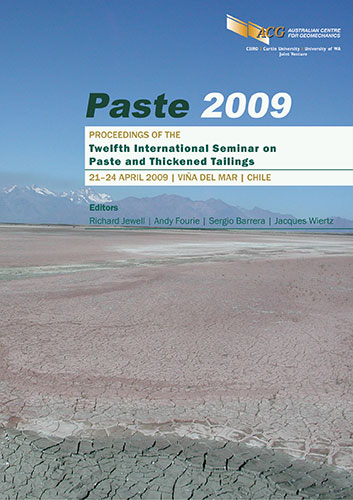Co-Disposal Plant and Distribution System to Allow the Proper Closure of Exxaro’s Hillendale Mine Site

|
Authors: Rusconi, JM; Goosen, P; Venter, J |
DOI https://doi.org/10.36487/ACG_repo/963_41
Cite As:
Rusconi, JM, Goosen, P & Venter, J 2009, 'Co-Disposal Plant and Distribution System to Allow the Proper Closure of Exxaro’s Hillendale Mine Site', in R Jewell, AB Fourie, S Barrera & J Wiertz (eds), Paste 2009: Proceedings of the Twelfth International Seminar on Paste and Thickened Tailings, Australian Centre for Geomechanics, Perth, pp. 375-382, https://doi.org/10.36487/ACG_repo/963_41
Abstract:
The run of mine ore from the Exxaro Hillendale Heavy Minerals operation contains distinct fine and coarse fractions. The fine fraction consists mainly of clay and is referred to as slimes. The coarse fraction consists mainly of sand. These are separated during the mineral recovery process. Traditionally these have been disposed of separately, either by refilling mining voids or in a tailings dam. However, in order to ensure that the land is returned to an arable state, the clay and sand need to be remixed in the same proportion in which they occur in the ore body and placed in a sufficiently thick capping layer as part of the final rehabilitation process on the mine site. During 2007, Paterson & Cooke were asked to design a plant capable of distributing 400 tonnes per hour of this mixture. It is required to finely control the ratio of sand to clay and deposit it at a high enough yield stress to prevent segregation on placement. This paper is a case study of the design, construction and commissioning of the plant.
References:
Exxaro KZN Sands (2007) Hillendale dune rehabilitation system concept philosophy, Richard’s Bay, South Africa
Krause, B. (2004) Development and application of paste fill using dry tailings, Proceedings of the Fifth International
Seminar on Paste and Thickened Tailings, A.B. Fourie, P. Slatter and A. Paterson (eds), Australian Centre for
Geomechanics, Perth, Australia, Paper 16.
382 Paste 2009, Viña del Mar, Chile
© Copyright 2025, Australian Centre for Geomechanics (ACG), The University of Western Australia. All rights reserved.
View copyright/legal information
Please direct any queries or error reports to repository-acg@uwa.edu.au
View copyright/legal information
Please direct any queries or error reports to repository-acg@uwa.edu.au